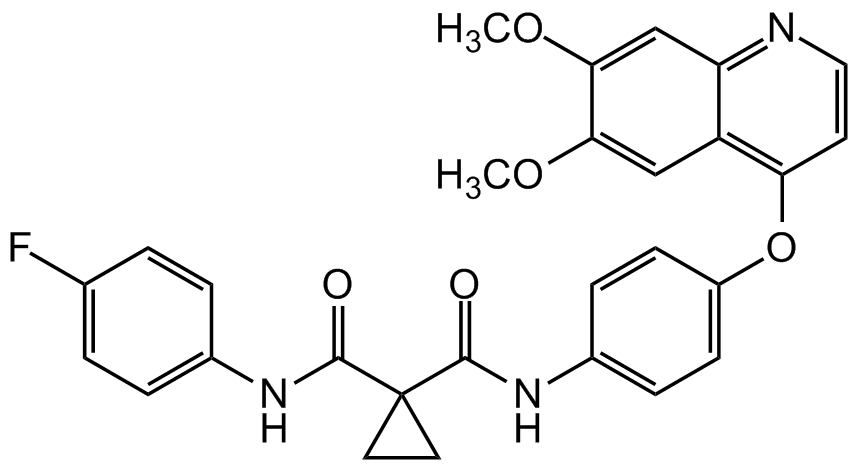Cabozantinib
| Code | Size | Price |
|---|
| CDX-C0755-M010 | 10 mg | £145.00 |
Quantity:
| CDX-C0755-M050 | 50 mg | £437.00 |
Quantity:
Prices exclude any Taxes / VAT
Overview
Regulatory Status: RUO
Shipping:
AMBIENT
Storage:
Short Term: +4°C Long Term: -20°C
Images
Documents
Further Information
Alternate Names/Synonyms:
BMS-907351; XL184
Appearance:
White to off-white solid.
CAS:
849217-68-1
EClass:
32160000
Form (Short):
liquid
Handling Advice:
Protect from light and moisture.
Hazards:
H302-H315-H319-H350
InChi:
InChI=1S/C28H24FN3O5/c1-35-24-15-21-22(16-25(24)36-2)30-14-11-23(21)37-20-9-7-19(8-10-20)32-27(34)28(12-13-28)26(33)31-18-5-3-17(29)4-6-18/h3-11,14-16H,12-13H2,1-2H3,(H,31,33)(H,32,34)
InChiKey:
ONIQOQHATWINJY-UHFFFAOYSA-N
Long Description:
Chemical. CAS: 849217-68-1. Formula: C28H24FN3O5. MW: 501.5. Cabozantinib is a potent multi-targeted receptor tyrosine kinase (RTK) inhibitor of endothelial growth factor receptor 2 (VEGFR2) (IC50=0.035nM), the hepatocyte growth factor receptor c-Met (IC50=1.3nM), AXL (IC50=7nM), fms like tyrosine kinase 3 (FLT3) (IC50=11.3nM), mast/stem cell growth factor (KIT) (IC50=4.6nM), RET (IC50=5.2nM), tyrosine-protein kinase receptor (TIE-2) (IC50=14.3nM) and RON (IC50=124nM). Cabozantinib reduces cell proliferation and vascular density. It also induces apoptosis and intratumoral hypoxia. Cabozantinib exhibits dose-related tumor growth inhibition, tumor regression, angiogenesis and/or metastasis inhibition in a broad range of preclinical tumor models. The anticancer compound cabozantinib has undergone clinical trial in a broad number of cancers, including thyroid carcinoma, prostate cancer, ovarian cancer, melanoma, breast cancer, non-small cell lung cancer, hepatocellular cancer, renal cell carcinoma and glioblastoma.
MDL:
MFCD20926324
Molecular Formula:
C28H24FN3O5
Molecular Weight:
501.5
Package Type:
Vial
Product Description:
Cabozantinib is a potent multi-targeted receptor tyrosine kinase (RTK) inhibitor of endothelial growth factor receptor 2 (VEGFR2) (IC50=0.035nM), the hepatocyte growth factor receptor c-Met (IC50=1.3nM), AXL (IC50=7nM), fms like tyrosine kinase 3 (FLT3) (IC50=11.3nM), mast/stem cell growth factor (KIT) (IC50=4.6nM), RET (IC50=5.2nM), tyrosine-protein kinase receptor (TIE-2) (IC50=14.3nM) and RON (IC50=124nM). Cabozantinib reduces cell proliferation and vascular density. It also induces apoptosis and intratumoral hypoxia. Cabozantinib exhibits dose-related tumor growth inhibition, tumor regression, angiogenesis and/or metastasis inhibition in a broad range of preclinical tumor models. The anticancer compound cabozantinib has undergone clinical trial in a broad number of cancers, including thyroid carcinoma, prostate cancer, ovarian cancer, melanoma, breast cancer, non-small cell lung cancer, hepatocellular cancer, renal cell carcinoma and glioblastoma.
Purity:
>98% (HPLC)
SMILES:
O=C(NC1=CC=C(OC2=C3C=C(C(OC)=CC3=NC=C2)OC)C=C1)C4(C(NC5=CC=C(C=C5)F)=O)CC4
Solubility Chemicals:
Soluble in DMSO (20mg/ml). Slightly soluble in ethanol.
Transportation:
Non-hazardous
UNSPSC Category:
Biochemical Reagents
UNSPSC Number:
12352200
Use & Stability:
Stable for at least 2 years after receipt when stored at -20°C.
References
(1) Y. Zhang, et al.; IDrugs 13, 112 (2010) | (2) R. Kurzrock, et al.; J. Clin. Oncol. 29, 2660 (2011) | (3) F.M. Yakes, et al.; Mol. Canc. Ther. 10, 2298 (2011) | (4) S. Roy, et al.; Anticancer Agents Med. Chem. 15, 37 (2015) (Review) | (5) N.M. Tannir, et al.; Curr. Oncol. Rep. 19, 14 (2017) (Review) | (6) C. Grullich; Recent Res. Cancer Res. 211, 67 (2018) (Review) | (7) J.N. Markowitz & K.M. Fancher;; Pharmacotherapy 38, 357 (2018) (Review) | (8) A. Desai & E.J. Small; Future Oncol. 15, 2337 (2019) (Review) | (9) J. Trojan; Drugs 80, 1203 (2020) (Review)



